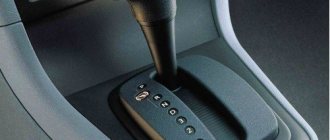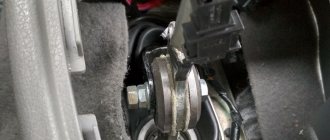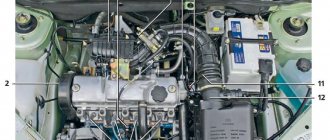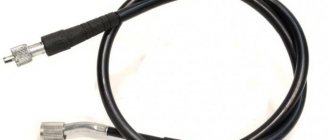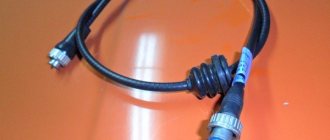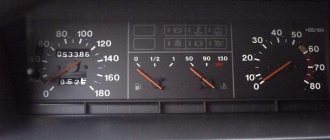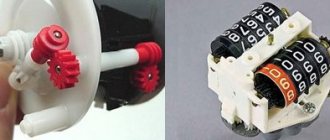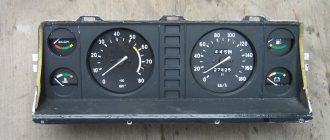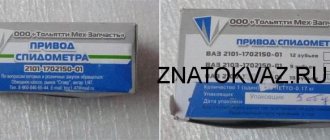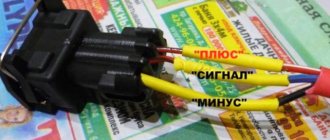A car consists of hundreds of parts and assemblies. This is a complex structure, each element of which has its own service life. It doesn’t matter what material a particular part is made of, during operation it is subject to wear, exhausting its safety margin.
The main criterion for determining the service life of car parts is its mileage - the length of the path traveled over the entire history of its use. The unit of measurement for the service life of car parts is “kilometers”. Before selling a car, many sellers have a question: how to wind the speedometer? This is what we will talk about.
What types of speedometers are there?
To understand how to wind a speedometer, you first need to understand the operation and types of the device itself.
A speedometer is an accurate metric instrument that measures the instantaneous speed of movement. One of the very first simple speedometers, invented and patented by Nikolo Tesla at the beginning of the last century.
It's hard to believe, but there are 11 types of this device.
- By measurement method:
- Electronic
- Induction
- Electromagnetic
- Vibrating
- Centrifugal
- Chronometric
- Positional – focused on satellite navigation
- According to indication;
Analog:
— Switch
— Tape
— Drums
Digital
We will not dwell long on the description of all these species (this is a separate topic). It should only be noted that digital devices have not taken root in the design of cars. The fact is that the numbers on the scoreboard changed too often (after all, the speed is measured every moment). The driver could not follow these changes and accurately determine the average speed. Experts tried to slow down the display, but this greatly distorted the data during braking and acceleration. Due to such circumstances, the manufacturer returned analogue, dial speedometers to the design.
In conventional car speedometers, another measuring device is built in - an odometer. So it measures mileage (in kilometers or miles). In addition, there is also a daily mileage counter, with a special mileage reset button (the official “rewind” of the speedometer).
Like all measuring instruments, the speedometer has an acceptable error. As a rule, deviations in car speedometers occur in the direction of increasing speed. It is measured not in kilometers, but as a percentage.
How to identify a “twisted” speedometer
When purchasing a used car, it is important to be able to recognize a “worn” speedometer. After all, the degree of wear of all parts of the car depends on the actual mileage.
Attention should be paid to some signs that indirectly prove the fact that the mileage has been increased.
- Determine by eye the degree of wear on the upholstery of the driver's seat, steering wheel, and pedal pads. Even the carpet under the driver's feet has a characteristic wear and tear.
- Knowing the year of manufacture of the car, the average annual mileage of a non-service vehicle (20 - 25 thousand km), by simple multiplication we obtain the approximate odometer reading (which should be). Comparing with real readings, certain conclusions can be drawn.
- Cars imported into the country from Europe have their mileage reduced to reduce the cost of customs duties. Most European cars have undergone this procedure.
- The condition of operating components and assemblies - engine, body, pulleys, color of exhaust gases, oil pressure, and much more, will also tell you a lot.
- During maintenance, the technician places a sticker under the hood with mileage data. Look for it and compare it with the speedometer readings.
- In a car with a mechanical speedometer, just look from below at the gearbox drive. Traces of dirt and scratches clearly indicate such manipulations.
So, it became clear why you need to “adjust” the mileage, how to adjust the speedometer, and how to recognize all this. Remember that without special skills and solid knowledge, you should not carry out such a procedure yourself; it is better to let qualified specialists do it.
Why shouldn’t you have a negative attitude towards increasing mileage?
Most car enthusiasts have a biased opinion towards those who decide to wind up the odometer. The fact is that unscrupulous sellers resort to rolling up the odometer, wanting to hide the true mileage in order to sell a used car at a higher price.
But it is worth noting that the mileage is reduced not only in the direction of decrease. There are objective situations that require increasing mileage:
- • The need to undergo maintenance at a service center ahead of schedule, for example, before a long trip.
- • Replacement of the instrument panel, resulting in a failure of the odometer readings.
- • The need to adjust mileage due to engine replacement.
- • Installation of wheels of non-standard diameter, due to which the actual mileage does not correspond to the actual one.
- • Fair compensation for fuel costs.
Of course, there are times when you need to reduce your mileage. Indeed, for a careful owner, the excellent condition of the car does not always correspond to the true mileage, which is especially upsetting during the sale, when the buyer, seeing an impressive number on the speedometer, demands to lower the price. In this case, it is enough to simply check the mileage if the otherwise good technical condition of the car does not reveal its real age.
Why is it dangerous to misrepresent the mileage when selling a car?
You can reduce mileage on any car, be it a 30-year-old Lada or a new Lexus. But the meaning of this operation is quite dubious. Of course, you will easily pay more attention to the advertisement for the sale of your car if its mileage over 10 years of operation is less than 100,000 kilometers. But in reality this is almost impossible, since transport is used more intensively in 80% of cases.
Interestingly, experienced motorists have learned to determine real mileage based on secondary signs. This is not only the readings of diagnostic equipment, but also the condition of the car interior, some leather and plastic parts, engine wear and emerging problems, the service book and the date it was last filled out, as well as the service history at your service station. There can be quite a lot of principles for determining real mileage.
What types of speedometers are there?
To understand how to wind a speedometer, you first need to understand the operation and types of the device itself.
A speedometer is an accurate metric instrument that measures the instantaneous speed of movement. One of the very first simple speedometers, invented and patented by Nikolo Tesla at the beginning of the last century.
It's hard to believe, but there are 11 types of this device.
- By measurement method:
- Electronic
- Induction
- Electromagnetic
- Vibrating
- Centrifugal
- Chronometric
- Positional – focused on satellite navigation
- According to indication;
Analog:
— Switch
— Tape
— Drums
Digital
We will not dwell long on the description of all these species (this is a separate topic). It should only be noted that digital devices have not taken root in the design of cars. The fact is that the numbers on the scoreboard changed too often (after all, the speed is measured every moment). The driver could not follow these changes and accurately determine the average speed. Experts tried to slow down the display, but this greatly distorted the data during braking and acceleration. Due to such circumstances, the manufacturer returned analogue, dial speedometers to the design.
In conventional car speedometers, another measuring device is built in - an odometer. So it measures mileage (in kilometers or miles). In addition, there is also a daily mileage counter, with a special mileage reset button (the official “rewind” of the speedometer).
Like all measuring instruments, the speedometer has an acceptable error. As a rule, deviations in car speedometers occur in the direction of increasing speed. It is measured not in kilometers, but as a percentage.
Ways to change speedometer readings
Despite the fact that the years that were accompanied by a total shortage have passed, nowadays it is now possible to purchase any auto part without difficulty, the habit of “embellishing” the condition of the vehicle has remained with car owners.
Car manufacturers have abandoned mechanical speedometers, equipping modern cars with electronic devices in order to somehow try to eradicate this addiction to deception, but it is completely impossible to stop it. Many people still strive to increase the speedometer mileage.
How to change the mechanical speedometer readings
Mechanical speedometers often accompanied technical means until the turn of the 20th and 21st centuries. Although some domestic cars continued to be equipped with them even before 2007.
Due to the fact that mechanical speedometers are simple devices, even an inexperienced car enthusiast can twist the speedometer himself, who will first familiarize himself with the advice of experienced craftsmen.
Initially, the speedometer is removed and connected to a motor, after starting which the mileage will automatically increase or decrease. By the way, some car owners, indeed, not only reduce the mileage, but also increase it, on the contrary, thereby convincing the buyer that a vehicle with a certain mileage has already successfully passed maintenance and therefore does not need repairs.
When removing the speedometer, it is impossible not to break the seal, so this trick may not work for all purchasers. Although some brands of cars are accompanied by fastening the speedometer in such a way that does not require its complete removal, it is enough to disconnect only the drive cable.
When trying to twist the speedometer, it is not recommended to rush, since the numbers will not be located on the same line when the motor is running quickly, giving away tricks of manipulation to the buyer.
How to change electromechanical and electronic speedometer readings
Electromechanical speedometers replaced mechanical ones in the eighties, but lasted until about 2008. The drive cables in them were replaced with electrical wires.
https://youtube.com/watch?v=a2_qSm-SXeE
Manufacturers installed special indicators in the gearbox that read pulses from the rotating modulator.
It is possible to twist an electromechanical speedometer using a special pulse generator, although some craftsmen manage to perform such work using an electric motor on which the modulator is directly installed.
Modern cars are already equipped with electronic speedometers, since manufacturers are interested in a serious degree of protection. Owners of modern technical equipment who want to know how to twist an electronic speedometer can get advice on this issue from experienced craftsmen, but one cannot hope for an easy solution to the problem.
In most cases, you cannot reduce or increase mileage yourself, so you have to turn to specialists
Unfortunately, this type of service is accompanied by a considerable cost, so it is important to weigh the feasibility of such actions
And yet, if someone really wants to know how to twist an electronic speedometer, the craftsmen can reveal the secret that all actions are accompanied by the use of computer equipment, in particular, a special programmer that connects directly to a microcircuit containing information about the car’s mileage.
Having ensured such a connection, the programmer manually enters the necessary parameters, changing the mileage of the car. You can check the mileage by connecting the computer to the diagnostic socket. The advantage of this method is that there is no need to remove the instrument panel. However, the disadvantage indicates that it is extremely difficult to have the appropriate software that allows such manipulations, since it is only available from the manufacturer or official dealer, who value the prestige of the company and are unlikely to want to distribute the software to everyone.
So, adjusting the speedometer indicator is a real relic of the past, which has confidently and firmly penetrated modern life and is not going to lose ground, allowing owners to “cunningly” but profitably sell their cars.
Why shouldn’t you have a negative attitude towards increasing mileage?
Most car enthusiasts have a biased opinion towards those who decide to wind up the odometer. The fact is that unscrupulous sellers resort to rolling up the odometer, wanting to hide the true mileage in order to sell a used car at a higher price.
But it is worth noting that the mileage is reduced not only in the direction of decrease. There are objective situations that require increasing mileage:
- • The need to undergo maintenance at a service center ahead of schedule, for example, before a long trip.
- • Replacement of the instrument panel, resulting in a failure of the odometer readings.
- • The need to adjust mileage due to engine replacement.
- • Installation of wheels of non-standard diameter, due to which the actual mileage does not correspond to the actual one.
- • Fair compensation for fuel costs.
Of course, there are times when you need to reduce your mileage. Indeed, for a careful owner, the excellent condition of the car does not always correspond to the true mileage, which is especially upsetting during the sale, when the buyer, seeing an impressive number on the speedometer, demands to lower the price. In this case, it is enough to simply check the mileage if the otherwise good technical condition of the car does not reveal its real age.
Common twisting methods
You can reduce mileage in the following ways:
Using the programmer, you need to dismantle the device and the terminal blocks directly connected to the wiring.
You can only remove the dashboard, connect the wire to the computer, and with a few keystrokes, set the required values.
When there is an “OBD” connector, you do not have to perform any installation and disassembly work. All you need is to insert one plug into the panel and the second into the computer.
The next option is more suitable for those who have some experience in such work. Another chip is soldered on top of the main chip. Thus, you can press the button and simply reset the readings on the odometer.
How can you reset the mileage of a vehicle?
To reset the mileage, you need to program the vehicle's electronic systems. Thanks to high-quality equipment, you can program the electronics and maintain the functionality of the rest of the dashboard.
This effect can be achieved through plug-in programming. This method of resetting mileage can be implemented if you have all access rights and recode the memory blocks.
They also install a microcircuit that will allow the sensor readings to be changed the required number of times.
There is a third way to change mileage readings. This is the use of external generators and data transfer. In such cases, it is necessary to completely decrypt the data.
It is a mistake to think that cooperation with companies that provide services for changing odometer readings is a waste of time and money: professionals who know all the nuances of the electronic components of foreign cars will do this work quickly and without consequences.
An inexperienced car owner in such a matter can, through his actions, completely disrupt the electronics of his car, rendering not only the odometer unusable, but also other devices that make up its integrity.
Good luck to you on your journey! No rod - no pits! Follow my new publications - it will be even more interesting!
What does a speedometer measure?
What does the speedometer measure? If you delve into the name, speed is speed (English), and meter (we won’t burden you with the Greek alphabet) is measure (Greek), which almost literally speaks of the measurement of speed with this device. And this device is already many years old. Its debut was in 1901 on the Oldsmobile. And the patent was received by Nikola Tesla only 15 years later. Although there is information that the verstomer, an invention of the self-taught serf mechanic Yegor Grigorievich Kuznetsov, was created in the 18th century. It was installed on mechanical tracks. The arrows of the verstomer showed the distance traveled, and the bell measured each verst with its ringing. The invention can be viewed in the Hermitage in St. Petersburg. Over the past century, the average person has been shown many different modifications of the device, both in the type of information provided and in the method of measuring it. Pointer and digital instruments are the most common today; graphic panels have appeared, like a laptop monitor. Older people may remember the tape speedometer, like on the GAZ-24 before 1975. On pre-war cars there were often drum ones, where the speed values were marked on the drum, which, when rotating, showed them in the window. Now you can see this on Citroen. There are also many options for measuring speed. They can be divided into groups:
- Mechanical speedometers (centrifugal, chronometric, vibration);
- Electromechanical (electromagnetic, induction) and electronic.
There are devices that determine speed through a satellite positioning system (GPS or GLONASS). However, a GPS speedometer for a car is more of an option that increases driver convenience. They are not installed standard from the factory.
Cost of work to correct readings
Many people today are wondering, how much does it cost to correct the speedometer readings?
As with any work, it all depends on its volume and complexity. If with a mechanical speedometer everything is quite simple, you just need to turn its drive in the right direction, if only you have free time, then with modern systems everything is much more complicated. This requires knowledge not only of automotive electronics, but sometimes even the qualifications of a programmer. In the first electronic speedometers, mileage data was recorded in the device’s memory and changing them was not very difficult. Now manufacturers duplicate this information in various electronic units (engine control unit, brake system control unit, immobilizer unit). In addition, this data can be encrypted. For the “brains” of the car to work correctly, it is necessary to change mileage data in all places where they are recorded, and this is quite complex and painstaking work. It is necessary not to damage the data of other systems, for example, the same immobilizer.
The distinctive advantages of the device for winding up the speedometer can be considered:
- • The device does not require special installation.
- • Connects via a diagnostic connector directly inside the car.
- • Any car owner can use the speedometer winder, since the device is easy to operate.
- • The spinner has a compact size, so it can even be stored in the glove compartment.
- • High winding speed of the speedometer can reach 5 thousand kilometers per hour.
- • The device is suitable for any brand of modern car, regardless of engine size or gearbox type.
- • Winding changes the mileage readings simultaneously in each duplicate block.
Instruments and devices for winding
If you don’t know how to rewind your mileage, but don’t want to go to a car service center, you can purchase a special device with which you can rewind the speedometer. There is a wide selection of mechanisms available on the market, which makes it possible to choose a device suitable for a particular car. These devices are easy to use, so any car enthusiast can adjust the speedometer. There are different options for speedometer winders, which differ in design and operating principle.
CAN twister
Speedometer corrector via digital CAN bus, used for modern cars equipped with a control unit. Through the CAN bus, blocks of electronic devices exchange impulses with each other. Before tightening the speedometer, the CAN twister must be inserted into the OBD diagnostic connector. It is located within the driver's reach, usually near the steering column. Thanks to exchange protocols, this connector allows you to access electronic devices.
Thus, using CAN knobs, you can adjust the necessary memory cells in the control unit to set the desired mileage. These devices are popular among dealers of used cars. They use them to twist the speedometer to reduce mileage. It is almost impossible to detect that changes have been made to memory cells, even with the use of modern equipment.
Pulse
The pulse speedometer corrector is used on imported cars that are equipped with a digital CAN bus. To use the device, you must insert it into the OBDII diagnostic connector located near the driver’s feet. Pulse winding of the speedometer sends impulses to the odometer, which are imitation of signals from the speed controller. With its help you can change the mileage readings.
Speed generator
A speed generator is a device that allows you to increase the mileage traveled by your car on its own. The device can be used on foreign cars manufactured before 2012. A special feature of these cars is that the speed signal does not come through the digital CA bus, but in the form of pulses.
The generator is connected to the OBDII diagnostic connector. It simulates the transmission of impulses that are received when a car moves. Using the device you can correct the odometer readings.
Other options
A universal device for winding up a speedometer is winding up a speedometer using a phone charger. The device is inserted into the cigarette lighter. The wire coming from the device is connected to the wiring using a female-male connector. This device can be used on both imported and domestic cars. To install it you do not need to have any special knowledge. The device comes with instructions for connection and use.
You can twist the speedometer using ABS twisters. This option can be used on cars that have an anti-lock braking system. The device uses a speed sensor and wheel rotation. When the device is connected to the desired connector, it begins to simulate the rotation of the wheels, according to which the sensor corrects the mileage readings on the odometer.
There is also a standard device for rewinding the speedometer. The speedometer corrector is turned on and off using a button located on its body. The device is equipped with a speed controller, so you can adjust the speed as you wish. The speedometer winding diagram for installation is included in the kit.
It is quite difficult to check the mileage on a modern car, which has a large number of electronics installed. But special devices allow you to change odometer readings without specialized knowledge.
Device types
There are three types of odometers:
- With mechanical drive. Such modifications are installed only in older cars. Cars with an electronic control unit are equipped with different odometers. Mechanical products have the largest calculation errors. This is due to the presence of a large number of elements in the drive, which, even when new, distort the data. The change in error depends on the degree of wear in the gear mechanism;
- Electronic fixation. Compared to a mechanical analogue, these devices have minimal error, because there are no parts in its design that reduce the effectiveness of the odometer. The device consists of a sensor mounted on the wheel (or in the transmission) and a screen. The signal from the reader is sent to the ECU. The program, using a programmed algorithm, calculates the number of kilometers traveled, which the driver is notified about by changing the numbers on the screen;
- Hybrid drive. It is a transitional link from mechanical to electronic. The speed is fixed mechanically - the speedometer cable rotates the wheel. There is a display on the instrument panel, so the driver sees not a mechanical counter, but electronic numbers. The data is calculated by the control unit of the vehicle's on-board system.
In mechanical models, breakdowns most often occur (mainly the teeth on the cable gears or dial elements break). They are also easier to roll up. Electronic models are the most stable, since malfunctions can be associated either with an error in the car’s control unit or with a breakdown of the sensor.
Mileage data in electronic modifications is not only recorded by the control unit, but also stored by the program. This makes it harder for scammers to cheat the mileage.
Reasons for mileage twisting
The electronic meter stopped counting mileage
There are quite a lot of people today who want to correct their car's mileage readings. And everyone justifies their desire differently. This includes a malfunction of the speedometer, replacement of the instrument panel, and driving on non-standard tires. Although, to be honest, the main justification for such actions is the desire to prolong the youth of your four-wheeled friend, perhaps for the purpose of subsequent sale. Selling a car with lower mileage is easier and more enjoyable to buy. Both the seller and the buyer are satisfied. By the way, when driving on non-standard tires, calibrating the speedometer will help solve the problem for a long time. And you won't need to regularly reduce your mileage. There are also those who want to increase their mileage. Mainly on commercial vehicles, or if the car is used for business purposes. This is also understandable in its own way. Often, the fuel consumption standards calculated by accounting departments do not cover the actual costs of gasoline. On the contrary, compensation for the use of personal transport only covers refueling, without taking into account depreciation and wear and tear of equipment. In an attempt to compensate for these costs, drivers resort to cunning and increase their mileage.
Winding instructions
How to wind the speedometer with your own hands? Much depends on the type of device, since for each individual type the winding pattern will be different. To complete the task, you need to know exactly what type of device the car is equipped with.
Mechanical
How to wind and how to wind up readings on a mechanical device, for example, on VAZ, GAZ cars? There are two options to rewind the speedometer. The first and simple one is to disconnect the cable from the speed sensor, the end that is attached to the box, connect the drill to it and turn the tool into reverse mode. As you understand, in a few minutes of work you can rewind a decent amount of mileage. The second method is to dismantle and disassemble the dashboard. After disassembly, the odometer (counter) itself is removed, and the mileage is finally adjusted. Note that the methods are relevant for domestic cars produced before 2005 (the author of the video is Do It Yourself).
Electromechanical
An electromechanical device can be found on older vehicles, but winding up this type of speedometer will be more difficult than a regular mechanical one. In this case, the winding or unwinding procedure requires different approaches. It must be taken into account that the reduction in mileage in the case of an electromechanical device is carried out by dismantling and disassembling the control panel. To rewind the readings, the meter must be dismantled, then the numbers must be adjusted manually.
As for increasing readings, the procedure is carried out using a generator. Thanks to the generator, signals are generated that are sent to the control input. In accordance with the number of pulses, device readings are formed.
Electronic
How to twist an electronic speedometer? As mentioned above, the devices are mounted on all modern cars. Correction of speedometer readings must be carried out in accordance with the production date of the vehicle. The bottom line is that an electronic device could be implemented in different ways during production, especially since it can interact with other devices (the author of the video is max gladkiy).
Therefore, in order to carry out the procedure for winding the speedometer, you will need not only to send a signal from the speed controller, but also to reconfigure some devices. It should be borne in mind that the process of accessing the device is determined in accordance with the model of the machine, as well as the year of manufacture; everything here is individual. Accordingly, adjusting the readings may be problematic, but it is possible. If you don’t know how to wind up an electronic speedometer, you will have to use a special device. We will describe the types of such devices below.
Rewinding the VAZ odometer upwards
| It so happened that I had to replace the VAZ dashboard with a new one. The replacement was completed, but the new instrument cluster has incorrect odometer readings. To save (continue) the odometer readings from the old tidy, you need to increase the mileage. |
- Program. The odometer programmer allows you to change the mileage using a special program and programmer. To do this you need to disassemble the instrument panel. Advantages: it is possible to set any odometer readings (decrease/rewind the odometer, or increase), the whole process does not require much time.
- Simulation of a speed sensor. In this case, there is no need to disassemble the dashboard. The point is to sequentially wind up the mileage using a generator (simulating a speed sensor). Disadvantages: you need to wait until the mileage accumulates, and the main thing is that it is an “odometer corrector” only in a larger direction. How to do this further:
Method 1: Computer sound card pulse generator program.
- A rectangular pulse generator program (for example, this one).
- Computer with sound card.
- Active speakers or amplifier to adjust the signal level.
Rewind the mileage, twist the speedometer Voronezh. Speedometer adjustment in Voronezh
Electronic speedometer
Almost every modern car is equipped with an electronic speedometer. Perhaps after a certain time it will completely replace mechanical analogues, but for now they are still present even in new models. The operating principle of the electronic device is simpler than that of a mechanical speedometer.
Often, an electronic device has a magnet in its device, which is attached to the output shaft of the gearbox. The magnet rotates with the shaft, and an electronic unit is located nearby. At the same time, rotating in a circle on the gearbox shaft, the magnet periodically passes in close proximity to the electronics, transmitting a signal to it and thereby performing the function of a sensor.
And every time the magnet passes by the block, it sends an impulse to the speedometer. Inside the meter there is a so-called black box (notable for its increased intelligence), which calculates the speed using these impulses. To wind the speedometer, this knowledge will not hurt.
There is nothing easier to understand: the faster the pulse transmission frequency, the faster the box shaft rotates. All calculations are performed with maximum accuracy and have almost zero error.
Electromechanical speedometers and odometers
With the transition to electromechanical systems, it has become more difficult to twist the speedometer. Information about the speed of movement was determined not by the number of revolutions of the transmission cable, but by a pulse generator that replaced the gearbox on the gearbox. The pulses were converted by a stepper motor into rotation of the worm gear shaft and wheels with numbers on the information board.
Now the odometer assembly was often non-separable, and in order to check the car’s mileage with your own hands, it was necessary to translate the numbers on the indicator wheels with a sharp awl, which created the risk of leaving traces of tampering. Now it was troublesome to twist the speedometer readings the old way.
About mileage spinners.
If something is already more or less clear with correction, then twisting is a separate area. On electronic speedometers without system data buses, everything was implemented by the same speed sensor emulator. They are popularly called Krutilki, Motalka, Podkrutka, all this is a pulse generator. The most optimal generator circuit for tweaking speedometers is obtained using an integrated timer 555. It does not need a voltage stabilizer, it is powered by 5-18 volts, it includes an output switch with an open collector and a current of up to 100 mA. Everything changed with the introduction of digital data buses into the auto industry. Nowadays, in cars with an ABS system, speed sensors are no longer installed, but the speed is taken from the ABS wheel sensors. The ABS module is connected to the CAN digital data bus, to which other vehicle modules (engine ECU, Speedometer, etc.) are also connected. The mileage specialists grabbed their heads. Emulating wheel sensors is very troublesome and needs to be done individually for each car. ABS swears at every little thing and produces a bunch of errors. Interfering with a critical part of the wiring is also a very bad step. But there was no other way out. But it is clear to everyone that winding through ABS is not an option, but it was used until another way to tighten the speedometer appeared. A new way of winding is to use a new generation of mileage winders that work directly with the car’s digital data bus itself. The point is that the mileage adjustment device will intercept messages with speed data and send its own at the required speed to add the mileage on the speedometer. Advantages of CAN winding devices: Small size. Low cost. Ease of use. The mileage is displayed not only in the speedometer, but also in other electronic modules. The car completely and truly thinks it is moving. And there are no electronic errors. On many cars (TOYOTA, FORD, NISSAN, INFINITI, LEXUS, RENAULT, SsangYong, Chevrolet), the CAN bus of the power plant is directly connected to the diagnostic connector. In such cars there is no need to install and connect the speedometer at all (yes, it’s just a miracle speedometer twister). Disadvantages of CAN winders: Each (almost every) car model has its own format and encoding of speed data. On some cars (Mercedes, Audi, VW, Skoda) it is necessary to connect the bus to the diagnostic connector or connect an additional 4-pin connector (whichever is more convenient for you). We have developed a speedometer screw circuit that is cost-effective and highly reliable. Thus, we can offer the cheapest Krutilki in Russia. We are also developing a network of representatives in different cities. If speedometers are your business, join our affiliate network. Our representatives receive an even lower cost of twisters, and an additional procedure for resetting the mileage limit as an additional source of income. It’s easy to become a representative, just buy a total of 5 spinners. Especially for our representatives, we have developed odometer checkers (All in one), which can change mileage on different cars.
The next step is to find the components for winding the run.
Mileage winding is in most cases a speed sensor simulator, i.e. the car seems to be moving at a certain speed.
In the store we will have to look for:
- AZ-2 or any similar device, this device was invented for carburetor cars, when their idle sensor failed so that they could continue driving. But in our time, when carburetors are reaching their end, they have found worthy use.
- The wires are about five meters long, 0.5 cross-section, the currents here are small;
- Plug into the cigarette lighter, you can do without it, but it’s more practical;
- Alligator clip for connecting to car wiring.
The diagram below shows how and which wires need to be soldered where:
Every city has an auto parts store that sells tuning parts, and most often you can find components there.
You must first connect to the line from the speed sensor, and then to the cigarette lighter. For a car, Gas on the electronic accelerator pedal is the green wire in the block next to the gas pedal. We make a neat cut with a knife in an inconspicuous place, exposing the wire so that we can hook the crocodile.
IMPORTANT! Do not rush to get upset if the speedometer needle lies flat after connecting, perhaps the car is in a position where the speed sensor hits the ground, so move the car forward or backward by 15 cm and the needle should rise. And also don't forget to turn on the ignition
When using this winding method, be extremely careful, because... the owner of the car may suspect that you are cheating, so I recommend not to be greedy, do everything evenly, and also reel in after the fact, i.e. every day, because so that a sudden check does not reveal any discrepancies between the waybill and the numbers on the speedometer. And if he finds out, it won’t hurt your pocket very much. Also, do not store the winding in a company car, because Your boss also has access to it; if he sees your device, he will definitely not envy you. And it’s not a bonus that will await you, but most likely a fine and a major audit.
When using this device, a drawback was identified: you need to leave the key in the ignition, which increases energy consumption. And it requires special control over the car, as it is susceptible to theft. Therefore, I suggest installing an adjustable time relay on the ignition. Those. so that we can set a timer and not be afraid for our car and the mileage.
Ps. : By the way, who is afraid to confuse plus with minus? In the AZ-1 and AZ-2 modules there is foolproof protection, i.e. If after inserting the plug into the cigarette lighter the light does not light, then swap the wires)))
Important elements of the dashboard
The main place on any dashboard is occupied by a speedometer with an integrated odometer - a sensor indicating the mileage of the car.
A speedometer is needed for a car to control the speed limit and follow traffic rules on road sections with limited speeds.
The odometer integrated into the speedometer usually shows two values - a certain mileage, which can be daily, mileage from refueling to refueling, etc. This value can always be reset, and the countdown will start again.
The second value that the odometer shows is the total mileage of the car.
This sensor is more important than the readings, which can be reset at any time.
Based on its readings, the necessary maintenance is carried out.
The frequency of a particular service is always indicated in the technical documentation that comes with the car, and this frequency is expressed in the total mileage of the car, which is precisely what the odometer shows.
Previously, mechanical odometers with a cable drive from the gearbox were installed on cars.
Nowadays, electronic devices are more common, displaying mileage information on a small display.
The data displayed on the display is indicated by the electronic control unit, based on the readings of certain sensors.
Despite its small size, the odometer has a rather complex design, so it is quite possible for it to fail.
Problems, for example, may arise with the instrument panel itself, as a result of which the instrument readings will be incorrect or will not be displayed at all.
In this case, the odometer reading will need to be adjusted.
It should be noted that dishonest car owners often use the correction of such readings before selling their car. They simply rewind the readings downward.
What to do if the speedometer and tachometer stop working
Replacing the speedometer cable on a VAZ 2101-VAZ 2107
Welcome! Speedometer cable - it is responsible for transmitting speed from the gearbox to the vehicle's speedometer instrument panel. One end of this cable is connected to the drive gearbox, which is located on the gearbox, and the other end is connected to the speedometer mechanism itself, which in turn is located on the instrument panel.
Note! To replace the cable, you will need to stock up on the following set of tools: First, be sure to stock up on basic tools, such as a screwdriver and wrenches. Next, you will need to take pliers, and also a wire approximately 2 meters long and with a diameter of 0.2-0.5 mm to make it easier to replace the cable!
- Replacing the speedometer cable
- Additional video clip
Where is the speedometer cable located? It is located near the bottom of the gearbox housing and is attached to the gearbox. For clarity, so that you have at least the slightest idea of where the cable is located, look at the photo below, where the arrow indicates the cable:
When should you change the speedometer cable? It must be replaced if:
- Failure, and therefore the speedometer will not show any values on the instrument panel.
- And also when it is deformed and when the nut that secures it to the gearbox or to the speedometer mechanism breaks.
Note! If you have a nut securing the cable to the gearbox, or to the speedometer, then the speedometer needle will jump sharply when driving!
How to replace the speedometer cable on a VAZ 2101-VAZ 2107?
Note! The cable must be replaced on a lift or inspection pit!
Removal: 1) At the beginning of the operation, you will need to remove the instrument panel from the car. (How to remove the instrument panel from a VAZ 2106 car, see the article: “Replacing the instrument panel”) (How to remove the instrument panel on a VAZ 2104 and VAZ 2107, see the article: “Replacing the instrument panel”)
Note! Unfortunately, instructions for removing the instrument panel on other cars of the classic family cannot be found on the Internet, so remove the panel on your car following the example of removing the panel from a VAZ 2104, VAZ 2106, VAZ 2107!
2) Next, using pliers, completely unscrew the nut that secures the cable to the mechanism, and after unscrewing, disconnect the cable.
Note! After disconnecting the cable, tie a 2-meter long wire to the cable nut by the eyes!
3) Then move to the bottom of the car, and there, unscrew the nut that secures the cable to the gearbox (it is indicated by the arrow), and after unscrewing the nut, disconnect the cable.
4) Now take the cable in your hands and pull it out of the car.
Note! Pull out the cable carefully; the wire that is connected to the cable nut should not be completely stretched out and, as a result, removed from the car!
5) Finally, untie the wire from the nut.
Installation:
Note! To extend the life of the cable, you can lubricate its surface with a special lubricant called “Litol-24”; to do this, before installing a new cable, first pull it out of the sheath starting from the side that is connected to the gearbox gearbox, and then lubricate it for “2/3 of the length”. lubricate it!
Do the entire installation of the cable in the reverse order of removal, but for clarity we will show you a small part of the installation:
1) First, take the new cable in your hands and tie the wire previously untied from the old cable to its nut.
2) Then sit in the passenger compartment and, pulling the wire, extend one end of the cable into the vehicle interior.
Note! To prevent you from getting confused, remember one important thing: The end of the cable that is connected to the gearbox located on the box is equipped with a protective cover, so install the cable correctly!
3) And at the end of the operation, use a screwdriver to tuck the cover into place.
Note! After installing the cable, check it, make sure that it is not bent in any places, and only then start the engine and drive it to see how it works!
Additional video clip: You can clearly see the second method of replacing the speedometer cable in a video clip prepared especially for you, in which everything is described and shown in detail.
Vaz-Russia.ru
How to recognize deception
On a mechanical odometer, the numbers are located on special drums and click upward as the mileage increases, and they must be lined up exactly in one line. If they are uneven, this is a sign of a twisted run. During correction, the numbers click in the reverse order and become crooked. You can inspect the speedometer cable attachment area to see if the fastening nut is unscrewed (it is better to ask someone who is well versed in cars).
You can check the mileage on any odometer - both mechanical and electronic. Fortunately, you can recognize deception in both cases!
If the odometer is electronic, then the best option is to go for diagnostics to a service center at an authorized dealer. Signs of a twisted mileage should be looked for on the dashboard itself. It is necessary to check whether it was removed or not and whether there are traces of tampering on the electronic circuits. Electronic circuit boards of instrument panels are manufactured at the factory and covered with a layer of varnish; traces of tampering in the form of soldered chips, erased varnish or cleaned tracks can be seen with the naked eye.
Also, the mileage readings are recorded in the car’s on-board computer, and if the mileage is corrected, then traces of hacking remain, which can be detected by an electronics specialist at the brand’s proprietary service center.
The original mileage of cars from America and Canada can be found through the Carfax and Autochek databases. For Japanese brands, the mileage is indicated on the auction sheet (a document that is filled out by auction experts before putting the car up for auction, it indicates the condition of the car, equipment and options), but this is possible when the car was just delivered; during resale, the sheet may be “lost” "
Let's sum it up
You can twist the mileage quite simply. This process is not difficult at all. It is enough to determine what readings on the odometer you want to see. It does not matter whether we are talking about a mechanical or electronic speedometer. The essence will always be the same. But it is worth remembering that mileage cheating is actually a crime for which compensation can be demanded through the court or the transaction can be canceled without any problems. Then you will have to return the money for the car and endure the most unpleasant moments after the sale. In most cases, cheating mileage does not pay for itself; it is better not to engage in such deception.
It must be said that in European countries it is not customary to inflate mileage, but in the CIS, every third seller on the market does this. Therefore, mileage has long ceased to be a determining factor in purchasing a car. Most likely, you will not be able to obtain certain benefits from rolling up the odometer readings. However, until twisting tools are blocked by manufacturers, our car sellers will actively use these tools. Have you ever checked the mileage of a car before selling it?
